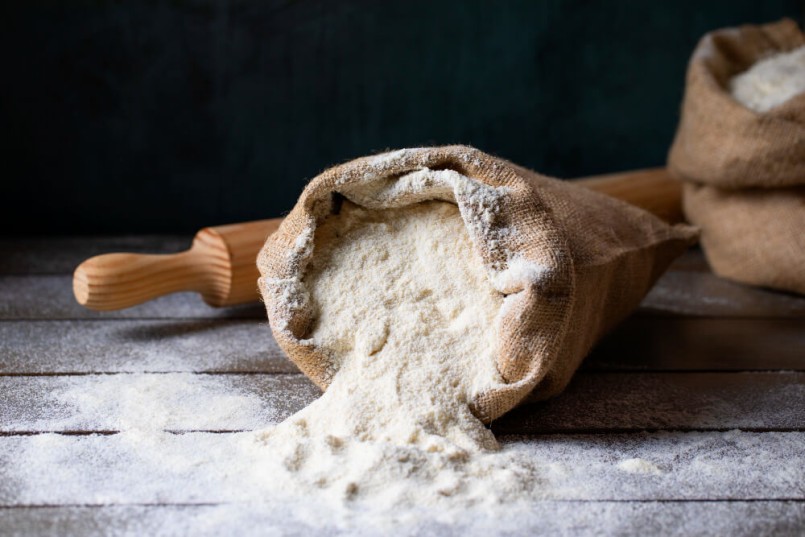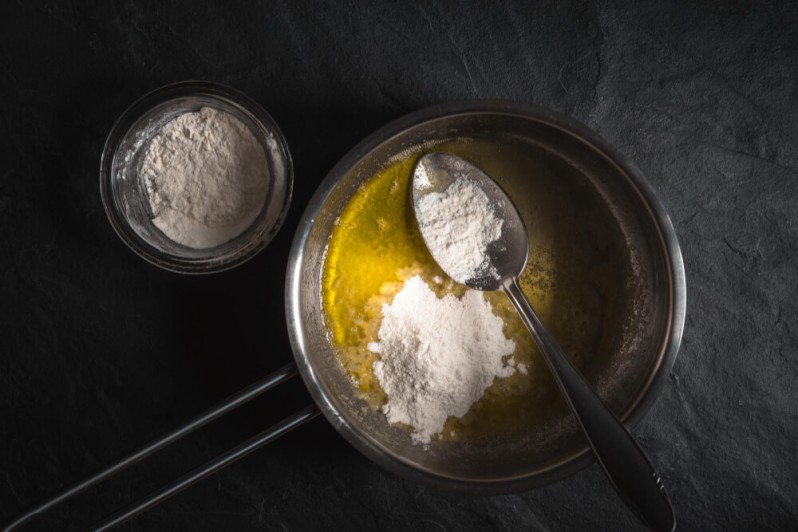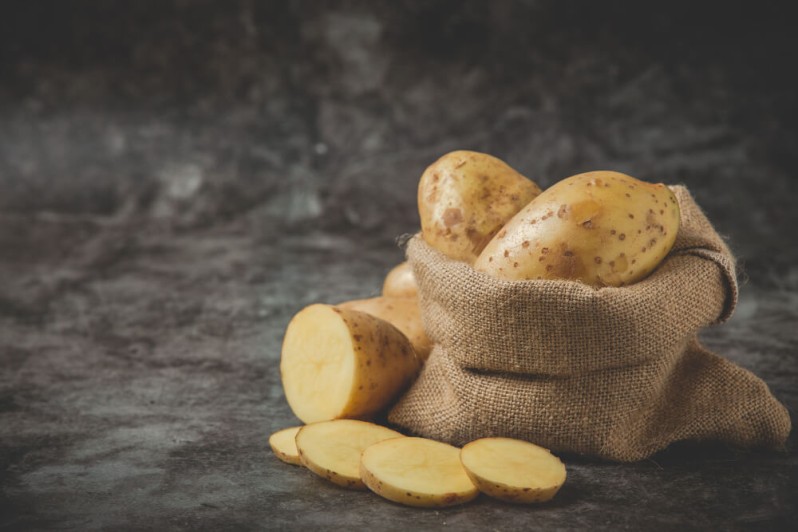
Step into the enchanting world of binders! Whether you are a seasoned chef or simply enjoy experimenting in the kitchen, binders are the secret key to creating dishes that delight your taste buds. In this article, we will delve deeper into the irresistible and versatile power of roux, a favorite among binders, and also explore some tempting alternatives. So put on your apron and let yourself be inspired!

Roux: The Chameleon among Thickeners
Roux, a classic and widely used thickener, is like a chameleon in the kitchen. With its French origin, roux adds a magical element to countless dishes. It is made by combining equal parts fat, such as butter, and flour. What makes roux so special is its ability to serve as a base for a variety of sauces, soups, and stews. Whether you're looking for a velvety béchamel sauce or a rich and creamy velouté, roux is the key to achieving the perfect texture and flavor.
Blonde roux, a step further in the cooking process, has a light golden color and a nutty aroma. By cooking the butter and flour slightly longer than in white roux, the roux develops more flavor. Blonde roux is often used in sauces like velouté, which acquire a subtle creaminess and a light nutty taste. It pairs well with poultry, fish, and vegetables.
With its versatility and adaptability, roux truly is a chameleon in the kitchen. By mastering the different types of roux and their applications, chefs can explore endless culinary possibilities and elevate dishes to a higher level. Whether you're creating a silky sauce or deepening the flavor of a stew, roux is an indispensable ingredient that lays the foundation for delicious and diverse dishes.
 Potatoes: A Natural Thickener
Potatoes: A Natural Thickener
In addition to roux, there is another natural thickener that can elevate your dishes to new culinary heights - potatoes! This versatile tuber not only offers a delicious taste and texture but also serves as an excellent thickening agent in various dishes. Potatoes contain starch, which is released during cooking and helps thicken and bind sauces, soups, and stews. Think of creamy mashed potatoes that can serve as a base for a savory gratin or a hearty potato soup that warms you up on a cold day. Using potatoes as a thickener not only adds flavor but also provides that delightful consistency you're looking for.
When choosing potatoes as a thickener, it's important to know which types work best. Potatoes with a high starch content, such as Russet potatoes, are ideal for binding dishes like mashed potatoes and stews. Yukon Gold potatoes, with their rich flavor and creamy texture, are perfect for gratins and creamy soups. Red Bliss potatoes, although slightly lower in starch content, can still be used for potato salads, thick soups, and stews where texture is desired.
Liason: The Perfect Connection
In addition to roux and potatoes, there is another thickening agent worth mentioning - liason. Liason is a combination of egg yolks and cream used to give sauces and soups a velvety texture. It is a delicate and luxurious binding that gives dishes a refined finish. Liason is often added at the end of the cooking process to enrich and thicken the sauce or soup. It is particularly suitable for creamy soups like a classic bisque or a silky sauce like a traditional hollandaise.
Tempting Alternatives: Dare to Experiment
While roux, potatoes, and liason are fantastic thickeners, it's always fun to discover new alternatives. Here are some tempting options to experiment with in your culinary adventures:
Modern Alternatives:
In addition to the aforementioned alternatives, there is another notable pioneer in this field, namely El Bulli, the legendary restaurant of chef Ferran Adrià. El Bulli introduced a series of revolutionary thickeners known as "texturas" that shook the culinary world. Some of these texturas include:
These "texturas" require creativity and an open mind but can lead to stunning results that will amaze your guests. While these texturas are primarily known in molecular gastronomy, they have also found their way into more everyday kitchens, where chefs experiment with these thickeners to create new flavor sensations.
Conclusion: Thickeners play an essential role in the kitchen, elevating your dishes to a higher level. Whether you choose the versatile roux, the natural power of potatoes, the luxurious liason, the innovative texturas from El Bulli, or other alternatives, each thickener adds its own unique flavor and texture to your creations. Dare to experiment and discover new culinary possibilities. So embark on a culinary journey in your kitchen and let the magic of thickeners enchant your taste buds. Enjoy your meal!

Roux: The Chameleon among Thickeners
Roux, a classic and widely used thickener, is like a chameleon in the kitchen. With its French origin, roux adds a magical element to countless dishes. It is made by combining equal parts fat, such as butter, and flour. What makes roux so special is its ability to serve as a base for a variety of sauces, soups, and stews. Whether you're looking for a velvety béchamel sauce or a rich and creamy velouté, roux is the key to achieving the perfect texture and flavor.
Roux comes in different variations, each with its own unique characteristics and culinary applications. The three main types of roux are white roux, blonde roux, and brown roux.
White roux is the most delicate variation. By cooking equal parts butter and flour until the flour is just cooked, a subtle roux with a neutral flavor is created. This white roux forms the base for creamy sauces like béchamel and is ideal when the sauce shouldn't overpower the dish. It's also an excellent thickener for soups and creams.
Blonde roux, a step further in the cooking process, has a light golden color and a nutty aroma. By cooking the butter and flour slightly longer than in white roux, the roux develops more flavor. Blonde roux is often used in sauces like velouté, which acquire a subtle creaminess and a light nutty taste. It pairs well with poultry, fish, and vegetables.
Brown roux, the most intensely cooked variation, has a deep brown color and a rich, nutty flavor. By cooking the butter and flour longer until they reach a caramel-like color, this powerful roux is created. Brown roux not only adds flavor but also imparts a dark color to sauces and stews. It is an essential ingredient in dishes like gumbo and classic French demi-glace sauce.
In addition to these basic types, there are variations of roux that offer additional flavors and colors. For example, "yellow roux" achieves a richer texture and a light yellow color by adding egg yolks to white roux. There is also a "dark roux," cooked to a deeper caramel color and with a more intense flavor than brown roux.
With its versatility and adaptability, roux truly is a chameleon in the kitchen. By mastering the different types of roux and their applications, chefs can explore endless culinary possibilities and elevate dishes to a higher level. Whether you're creating a silky sauce or deepening the flavor of a stew, roux is an indispensable ingredient that lays the foundation for delicious and diverse dishes.
 Potatoes: A Natural Thickener
Potatoes: A Natural ThickenerIn addition to roux, there is another natural thickener that can elevate your dishes to new culinary heights - potatoes! This versatile tuber not only offers a delicious taste and texture but also serves as an excellent thickening agent in various dishes. Potatoes contain starch, which is released during cooking and helps thicken and bind sauces, soups, and stews. Think of creamy mashed potatoes that can serve as a base for a savory gratin or a hearty potato soup that warms you up on a cold day. Using potatoes as a thickener not only adds flavor but also provides that delightful consistency you're looking for.
When choosing potatoes as a thickener, it's important to know which types work best. Potatoes with a high starch content, such as Russet potatoes, are ideal for binding dishes like mashed potatoes and stews. Yukon Gold potatoes, with their rich flavor and creamy texture, are perfect for gratins and creamy soups. Red Bliss potatoes, although slightly lower in starch content, can still be used for potato salads, thick soups, and stews where texture is desired.
Liason: The Perfect Connection
In addition to roux and potatoes, there is another thickening agent worth mentioning - liason. Liason is a combination of egg yolks and cream used to give sauces and soups a velvety texture. It is a delicate and luxurious binding that gives dishes a refined finish. Liason is often added at the end of the cooking process to enrich and thicken the sauce or soup. It is particularly suitable for creamy soups like a classic bisque or a silky sauce like a traditional hollandaise.
Tempting Alternatives: Dare to Experiment
While roux, potatoes, and liason are fantastic thickeners, it's always fun to discover new alternatives. Here are some tempting options to experiment with in your culinary adventures:
- Cornstarch: Cornstarch, also known as cornflour, is a widely used thickener that is readily available in most kitchens. It's ideal for thickening sauces and soups and is a great alternative for people with gluten intolerance.
- Gelatin: Gelatin is a thickener primarily used in sweet dishes like puddings and jellies. It gives dishes a firm and smooth texture and can also be used to make savory aspics.
- Arrowroot: Arrowroot is a starch extracted from the roots of the arrowroot plant. It is a gluten-free thickener that is ideal for thickening sauces and soups, especially those with delicate flavors.
- Xanthan gum: For those following a vegan or gluten-free diet, xanthan gum is an excellent choice. It is a natural thickener derived from fermented sugar and can be used in a wide range of dishes.
- Amaranth flakes: Amaranth flakes can be used to thicken dishes and add a crunchy bite. They are particularly handy for rescuing overly wet casseroles or vegetable dishes.
- Chia seeds: Chia seeds are not only a great source of nutrients but also a fantastic thickener. They can be used in both sweet and savory dishes and provide a healthy binding effect.
- Carob bean gum: Carob bean gum, made from ground sprouted seeds of the carob tree, is a clear and flavorless thickener. It is often used in baby food and can also be used to thicken sauces, soups, and desserts.
- Kuzu: Kuzu, made from the root of the kuzu plant, is not only a functional thickener but also a healthy choice. It has a cleansing effect on the intestines and can be used to thicken soups, sauces, and desserts.
Modern Alternatives:
In addition to the aforementioned alternatives, there is another notable pioneer in this field, namely El Bulli, the legendary restaurant of chef Ferran Adrià. El Bulli introduced a series of revolutionary thickeners known as "texturas" that shook the culinary world. Some of these texturas include:
- Xanthan gum: Used for stabilizing and thickening dishes, xanthan gum is made from fermented sugars and is suitable for gluten-free and vegan diets.
- Agar Agar: A vegan alternative to gelatin, agar agar is made from seaweed and is perfect for making jellies, panna cotta, and other gel-like desserts.
- Methylcellulose: This unique textura creates interesting textures as it thickens when heated and becomes liquid when cooled, unlike most other thickeners. It is often used in molecular gastronomy.
- Calcic: Calcic is used in spherification, a technique popularized by El Bulli, where liquids are transformed into small "caviar-like" spheres.
- Algin: Algin is used in combination with Calcic for spherification. It is also used to thicken and stabilize dishes.
These "texturas" require creativity and an open mind but can lead to stunning results that will amaze your guests. While these texturas are primarily known in molecular gastronomy, they have also found their way into more everyday kitchens, where chefs experiment with these thickeners to create new flavor sensations.
Conclusion: Thickeners play an essential role in the kitchen, elevating your dishes to a higher level. Whether you choose the versatile roux, the natural power of potatoes, the luxurious liason, the innovative texturas from El Bulli, or other alternatives, each thickener adds its own unique flavor and texture to your creations. Dare to experiment and discover new culinary possibilities. So embark on a culinary journey in your kitchen and let the magic of thickeners enchant your taste buds. Enjoy your meal!
